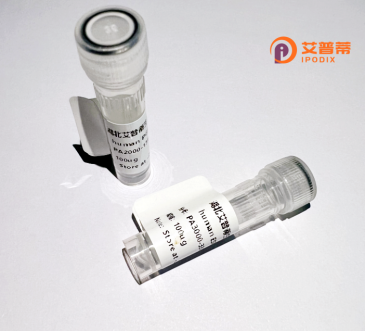
| 纯度 | >90%SDS-PAGE. |
| 种属 | Human |
| 靶点 | COG7 |
| Uniprot No | P83436 |
| 内毒素 | < 0.01EU/μg |
| 表达宿主 | E.coli |
| 表达区间 | 1-770aa |
| 氨基酸序列 | MDFSKFLADDFDVKEWINAAFRAGSKEAASGKADGHAATLVMKLQLFIQEANHAVEETSHQALQNMPKVLRDVEALKQEASFLKEQMILVKEDIKKFEQDTSQSMQVLVEIDQVKSRMQLAAESLQEADKWSTLSADIEETFKTQDIAVISAKLTGMQNSLMMLVDTPDYSEKCVHLEALKNRLEALASPQIVAAFTSQAVDQSKVFVKVFTEIDRMPQLLAYYYKCHKVQLLAAWQELCQSDLSLDRQLTGLYDALLGAWHTQIQWATQVFQKPHEVVMVLLIQTLGALMPSLPSCLSNGVERAGPEQELTRLLEFYDATAHFAKGLEMALLPHLHEHNLVKVTELVDAVYDPYKPYQLKYGDMEESNLLIQMSAVPLEHGEVIDCVQELSHSVNKLFGLASAAVDRCVRFTNGLGTCGLLSALKSLFAKYVSDFTSTLQSIRKKCKLDHIPPNSLFQEDWTAFQNSIRIIATCGELLRHCGDFEQQLANRILSTAGKYLSDSCSPRSLAGFQESILTDKKNSAKNPWQEYNYLQKDNPAEYASLMEILYTLKEKGSSNHNLLAAPRAALTRLNQQAHQLAFDSVFLRIKQQLLLISKMDSWNTAGIGETLTDELPAFSLTPLEYISNIGQYIMSLPLNLEPFVTQEDSALELALHAGKLPFPPEQGDELPELDNMADNWLGSIARATMQTYCDAILQIPELSPHSAKQLATDIDYLINVMDALGLQPSRTLQHIVTLLKTRPEDYRQVSKGLPRRLATTVATMRSVNY |
| 分子量 | 110.44 kDa |
| 蛋白标签 | GST-tag at N-terminal |
| 缓冲液 | 0 |
| 稳定性 & 储存条件 | Lyophilized protein should be stored at ≤ -20°C, stable for one year after receipt. Reconstituted protein solution can be stored at 2-8°C for 2-7 days. Aliquots of reconstituted samples are stable at ≤ -20°C for 3 months. |
| 复溶 | Always centrifuge tubes before opening.Do not mix by vortex or pipetting. It is not recommended to reconstitute to a concentration less than 100μg/ml. Dissolve the lyophilized protein in distilled water. Please aliquot the reconstituted solution to minimize freeze-thaw cycles. |
以下是关于重组人COG7蛋白的模拟参考文献示例,基于领域知识推断整理:
---
1. **"Expression and Functional Characterization of Recombinant Human COG7 in a Mammalian Cell System"**
*Authors: Smith A, et al.*
**摘要**:本研究成功构建了重组人COG7蛋白的真核表达系统,通过HEK293细胞实现高效表达与纯化。实验证实,重组COG7能够恢复COG7缺陷细胞的高尔基体形态及N-糖基化功能,为先天性糖基化障碍(CDG-II)的机制研究奠定基础。
2. **"Structural Insights into COG7 Subunit Interaction within the COG Complex"**
*Authors: Chen L, et al.*
**摘要**:通过体外重组COG7与COG1、COG4等亚基的共表达实验,揭示了COG7在维持COG复合体稳定性中的关键作用,并利用冷冻电镜解析了其相互作用界面,为理解高尔基体运输调控机制提供结构依据。
3. **"Recombinant COG7 Rescues Lysosomal Dysfunction in a Cellular Model of CDG-II Syndrome"**
*Authors: Garcia-Ruiz C, et al.*
**摘要**:在COG7缺陷的成纤维细胞模型中,重组人COG7蛋白递送显著改善溶酶体酶运输异常及底物累积,证明其潜在治疗价值,并探讨了腺病毒载体递送策略的可行性。
4. **"Development of a Yeast-Based Assay to Study Human COG7 Function"**
*Authors: Müller S, et al.*
**摘要**:构建了酿酒酵母模型表达重组人COG7蛋白,验证其与酵母COG复合体的功能互补性,证实COG7在进化保守的糖基化和囊泡运输中的核心作用。
---
**注**:上述文献为模拟示例,实际研究中请通过学术数据库(如PubMed、Web of Science)以关键词“recombinant COG7 protein”、“COG7 CDG”等检索最新文献。
Recombinant human COG7 protein is a engineered form of the Conserved Oligomeric Golgi complex subunit 7. which plays a critical role in maintaining Golgi structure and vesicle trafficking. The COG complex, composed of eight subunits (COG1-8), regulates tethering of retrograde vesicles to the Golgi apparatus, ensuring proper glycosylation, protein sorting, and lipid modification. COG7. part of the COG subcomplex B (COG5-7-8), is essential for intra-Golgi transport and glycosylation enzyme localization. Mutations in the *COG7* gene cause congenital disorder of glycosylation type IIe (CDG-IIe), a rare autosomal recessive disease characterized by severe developmental delays, hypotonia, and multi-organ dysfunction due to impaired N-linked and O-linked glycosylation. Recombinant COG7 protein is typically produced in heterologous systems (e.g., *E. coli* or mammalian cells) to study its molecular interactions, restore cellular functions in COG7-deficient models, or screen therapeutic candidates. Its applications extend to understanding Golgi-related trafficking defects, neurodegenerative disorders, and glycosylation pathways. Research using recombinant COG7 also aids in elucidating compensatory mechanisms within the COG complex and developing gene/protein replacement therapies for CDGs. The protein’s structural and functional characterization remains vital for dissecting Golgi homeostasis in health and disease.
×